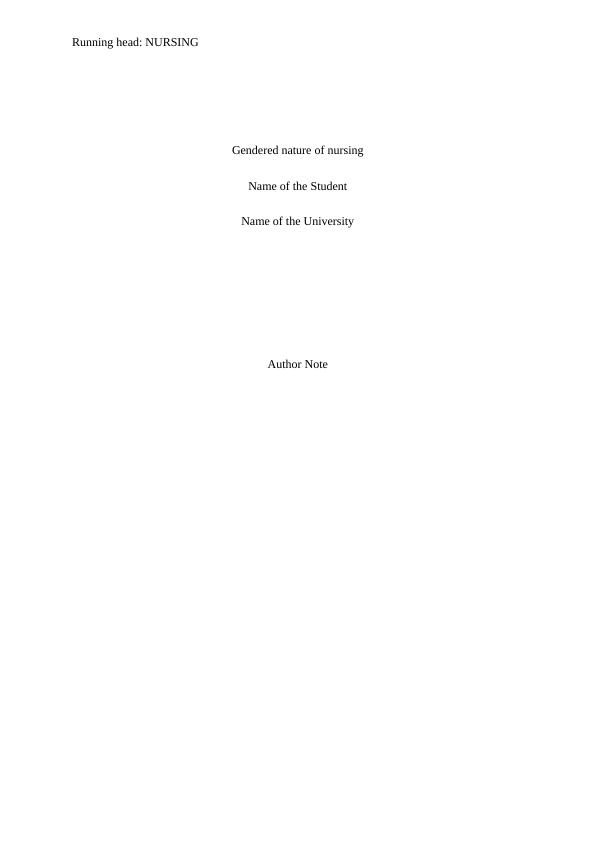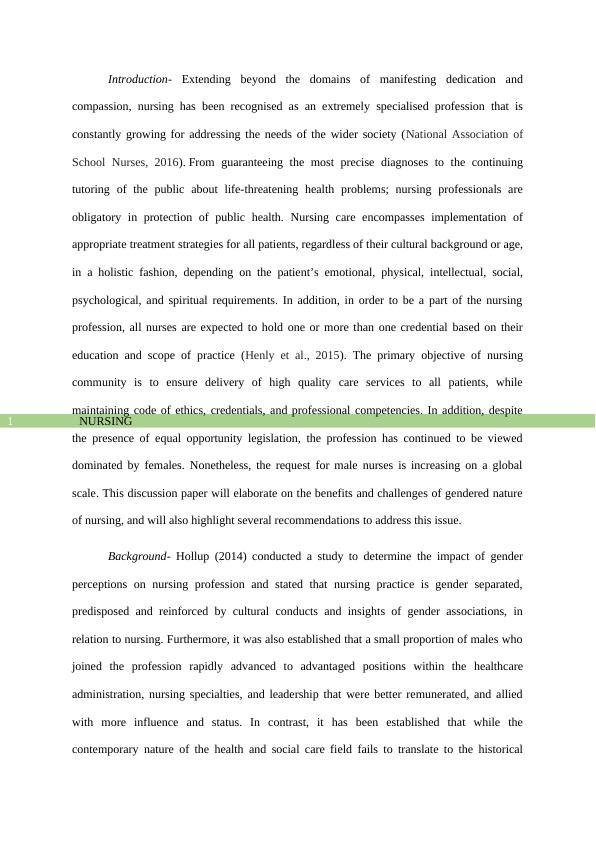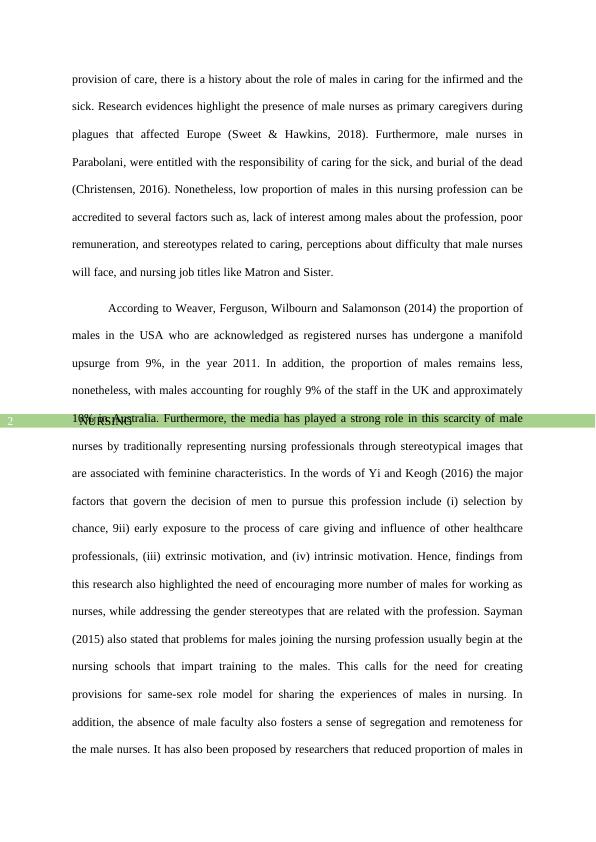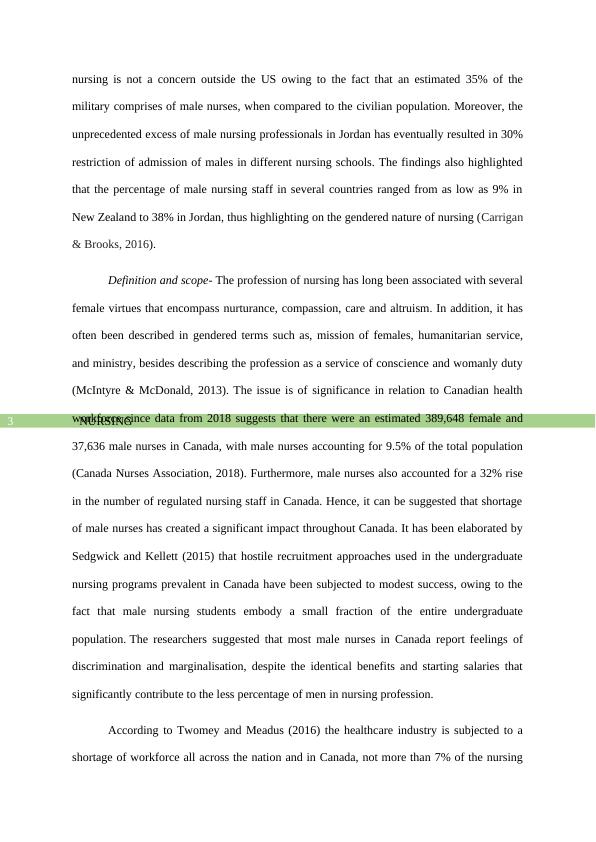Gendered nature of nursing
Added on 2022-11-25
15 Pages4363 Words72 Views
Running head: NURSING
Gendered nature of nursing
Name of the Student
Name of the University
Author Note
Gendered nature of nursing
Name of the Student
Name of the University
Author Note

NURSING1
Introduction- Extending beyond the domains of manifesting dedication and
compassion, nursing has been recognised as an extremely specialised profession that is
constantly growing for addressing the needs of the wider society (National Association of
School Nurses, 2016). From guaranteeing the most precise diagnoses to the continuing
tutoring of the public about life-threatening health problems; nursing professionals are
obligatory in protection of public health. Nursing care encompasses implementation of
appropriate treatment strategies for all patients, regardless of their cultural background or age,
in a holistic fashion, depending on the patient’s emotional, physical, intellectual, social,
psychological, and spiritual requirements. In addition, in order to be a part of the nursing
profession, all nurses are expected to hold one or more than one credential based on their
education and scope of practice (Henly et al., 2015). The primary objective of nursing
community is to ensure delivery of high quality care services to all patients, while
maintaining code of ethics, credentials, and professional competencies. In addition, despite
the presence of equal opportunity legislation, the profession has continued to be viewed
dominated by females. Nonetheless, the request for male nurses is increasing on a global
scale. This discussion paper will elaborate on the benefits and challenges of gendered nature
of nursing, and will also highlight several recommendations to address this issue.
Background- Hollup (2014) conducted a study to determine the impact of gender
perceptions on nursing profession and stated that nursing practice is gender separated,
predisposed and reinforced by cultural conducts and insights of gender associations, in
relation to nursing. Furthermore, it was also established that a small proportion of males who
joined the profession rapidly advanced to advantaged positions within the healthcare
administration, nursing specialties, and leadership that were better remunerated, and allied
with more influence and status. In contrast, it has been established that while the
contemporary nature of the health and social care field fails to translate to the historical
Introduction- Extending beyond the domains of manifesting dedication and
compassion, nursing has been recognised as an extremely specialised profession that is
constantly growing for addressing the needs of the wider society (National Association of
School Nurses, 2016). From guaranteeing the most precise diagnoses to the continuing
tutoring of the public about life-threatening health problems; nursing professionals are
obligatory in protection of public health. Nursing care encompasses implementation of
appropriate treatment strategies for all patients, regardless of their cultural background or age,
in a holistic fashion, depending on the patient’s emotional, physical, intellectual, social,
psychological, and spiritual requirements. In addition, in order to be a part of the nursing
profession, all nurses are expected to hold one or more than one credential based on their
education and scope of practice (Henly et al., 2015). The primary objective of nursing
community is to ensure delivery of high quality care services to all patients, while
maintaining code of ethics, credentials, and professional competencies. In addition, despite
the presence of equal opportunity legislation, the profession has continued to be viewed
dominated by females. Nonetheless, the request for male nurses is increasing on a global
scale. This discussion paper will elaborate on the benefits and challenges of gendered nature
of nursing, and will also highlight several recommendations to address this issue.
Background- Hollup (2014) conducted a study to determine the impact of gender
perceptions on nursing profession and stated that nursing practice is gender separated,
predisposed and reinforced by cultural conducts and insights of gender associations, in
relation to nursing. Furthermore, it was also established that a small proportion of males who
joined the profession rapidly advanced to advantaged positions within the healthcare
administration, nursing specialties, and leadership that were better remunerated, and allied
with more influence and status. In contrast, it has been established that while the
contemporary nature of the health and social care field fails to translate to the historical

NURSING2
provision of care, there is a history about the role of males in caring for the infirmed and the
sick. Research evidences highlight the presence of male nurses as primary caregivers during
plagues that affected Europe (Sweet & Hawkins, 2018). Furthermore, male nurses in
Parabolani, were entitled with the responsibility of caring for the sick, and burial of the dead
(Christensen, 2016). Nonetheless, low proportion of males in this nursing profession can be
accredited to several factors such as, lack of interest among males about the profession, poor
remuneration, and stereotypes related to caring, perceptions about difficulty that male nurses
will face, and nursing job titles like Matron and Sister.
According to Weaver, Ferguson, Wilbourn and Salamonson (2014) the proportion of
males in the USA who are acknowledged as registered nurses has undergone a manifold
upsurge from 9%, in the year 2011. In addition, the proportion of males remains less,
nonetheless, with males accounting for roughly 9% of the staff in the UK and approximately
10% in Australia. Furthermore, the media has played a strong role in this scarcity of male
nurses by traditionally representing nursing professionals through stereotypical images that
are associated with feminine characteristics. In the words of Yi and Keogh (2016) the major
factors that govern the decision of men to pursue this profession include (i) selection by
chance, 9ii) early exposure to the process of care giving and influence of other healthcare
professionals, (iii) extrinsic motivation, and (iv) intrinsic motivation. Hence, findings from
this research also highlighted the need of encouraging more number of males for working as
nurses, while addressing the gender stereotypes that are related with the profession. Sayman
(2015) also stated that problems for males joining the nursing profession usually begin at the
nursing schools that impart training to the males. This calls for the need for creating
provisions for same-sex role model for sharing the experiences of males in nursing. In
addition, the absence of male faculty also fosters a sense of segregation and remoteness for
the male nurses. It has also been proposed by researchers that reduced proportion of males in
provision of care, there is a history about the role of males in caring for the infirmed and the
sick. Research evidences highlight the presence of male nurses as primary caregivers during
plagues that affected Europe (Sweet & Hawkins, 2018). Furthermore, male nurses in
Parabolani, were entitled with the responsibility of caring for the sick, and burial of the dead
(Christensen, 2016). Nonetheless, low proportion of males in this nursing profession can be
accredited to several factors such as, lack of interest among males about the profession, poor
remuneration, and stereotypes related to caring, perceptions about difficulty that male nurses
will face, and nursing job titles like Matron and Sister.
According to Weaver, Ferguson, Wilbourn and Salamonson (2014) the proportion of
males in the USA who are acknowledged as registered nurses has undergone a manifold
upsurge from 9%, in the year 2011. In addition, the proportion of males remains less,
nonetheless, with males accounting for roughly 9% of the staff in the UK and approximately
10% in Australia. Furthermore, the media has played a strong role in this scarcity of male
nurses by traditionally representing nursing professionals through stereotypical images that
are associated with feminine characteristics. In the words of Yi and Keogh (2016) the major
factors that govern the decision of men to pursue this profession include (i) selection by
chance, 9ii) early exposure to the process of care giving and influence of other healthcare
professionals, (iii) extrinsic motivation, and (iv) intrinsic motivation. Hence, findings from
this research also highlighted the need of encouraging more number of males for working as
nurses, while addressing the gender stereotypes that are related with the profession. Sayman
(2015) also stated that problems for males joining the nursing profession usually begin at the
nursing schools that impart training to the males. This calls for the need for creating
provisions for same-sex role model for sharing the experiences of males in nursing. In
addition, the absence of male faculty also fosters a sense of segregation and remoteness for
the male nurses. It has also been proposed by researchers that reduced proportion of males in

NURSING3
nursing is not a concern outside the US owing to the fact that an estimated 35% of the
military comprises of male nurses, when compared to the civilian population. Moreover, the
unprecedented excess of male nursing professionals in Jordan has eventually resulted in 30%
restriction of admission of males in different nursing schools. The findings also highlighted
that the percentage of male nursing staff in several countries ranged from as low as 9% in
New Zealand to 38% in Jordan, thus highlighting on the gendered nature of nursing (Carrigan
& Brooks, 2016).
Definition and scope- The profession of nursing has long been associated with several
female virtues that encompass nurturance, compassion, care and altruism. In addition, it has
often been described in gendered terms such as, mission of females, humanitarian service,
and ministry, besides describing the profession as a service of conscience and womanly duty
(McIntyre & McDonald, 2013). The issue is of significance in relation to Canadian health
workforce since data from 2018 suggests that there were an estimated 389,648 female and
37,636 male nurses in Canada, with male nurses accounting for 9.5% of the total population
(Canada Nurses Association, 2018). Furthermore, male nurses also accounted for a 32% rise
in the number of regulated nursing staff in Canada. Hence, it can be suggested that shortage
of male nurses has created a significant impact throughout Canada. It has been elaborated by
Sedgwick and Kellett (2015) that hostile recruitment approaches used in the undergraduate
nursing programs prevalent in Canada have been subjected to modest success, owing to the
fact that male nursing students embody a small fraction of the entire undergraduate
population. The researchers suggested that most male nurses in Canada report feelings of
discrimination and marginalisation, despite the identical benefits and starting salaries that
significantly contribute to the less percentage of men in nursing profession.
According to Twomey and Meadus (2016) the healthcare industry is subjected to a
shortage of workforce all across the nation and in Canada, not more than 7% of the nursing
nursing is not a concern outside the US owing to the fact that an estimated 35% of the
military comprises of male nurses, when compared to the civilian population. Moreover, the
unprecedented excess of male nursing professionals in Jordan has eventually resulted in 30%
restriction of admission of males in different nursing schools. The findings also highlighted
that the percentage of male nursing staff in several countries ranged from as low as 9% in
New Zealand to 38% in Jordan, thus highlighting on the gendered nature of nursing (Carrigan
& Brooks, 2016).
Definition and scope- The profession of nursing has long been associated with several
female virtues that encompass nurturance, compassion, care and altruism. In addition, it has
often been described in gendered terms such as, mission of females, humanitarian service,
and ministry, besides describing the profession as a service of conscience and womanly duty
(McIntyre & McDonald, 2013). The issue is of significance in relation to Canadian health
workforce since data from 2018 suggests that there were an estimated 389,648 female and
37,636 male nurses in Canada, with male nurses accounting for 9.5% of the total population
(Canada Nurses Association, 2018). Furthermore, male nurses also accounted for a 32% rise
in the number of regulated nursing staff in Canada. Hence, it can be suggested that shortage
of male nurses has created a significant impact throughout Canada. It has been elaborated by
Sedgwick and Kellett (2015) that hostile recruitment approaches used in the undergraduate
nursing programs prevalent in Canada have been subjected to modest success, owing to the
fact that male nursing students embody a small fraction of the entire undergraduate
population. The researchers suggested that most male nurses in Canada report feelings of
discrimination and marginalisation, despite the identical benefits and starting salaries that
significantly contribute to the less percentage of men in nursing profession.
According to Twomey and Meadus (2016) the healthcare industry is subjected to a
shortage of workforce all across the nation and in Canada, not more than 7% of the nursing

End of preview
Want to access all the pages? Upload your documents or become a member.
Related Documents
Trends And Issues in Nursing And Health Systemlg...
|9
|2335
|34
Integration of Evidence Based Practice in Nursinglg...
|13
|3258
|86
Role and Responsibilities of Nursing Profession in Healthcarelg...
|7
|1931
|75
Nursing Assignment: Cultural Competence in Practicelg...
|6
|1370
|322
Medico Legal and Ethics in Health Carelg...
|12
|3574
|262
Ethics and Professional Issueslg...
|9
|2474
|24
